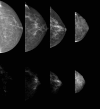Breast Imaging Reporting and Data System (BI-RADS) breast composition descriptors: automated measurement development for full field digital mammography
- PMID: 24320473
- PMCID: PMC3820635
- DOI: 10.1118/1.4824319
Breast Imaging Reporting and Data System (BI-RADS) breast composition descriptors: automated measurement development for full field digital mammography
Abstract
Purpose: The Breast Imaging Reporting and Data System (BI-RADS) breast composition descriptors are used for standardized mammographic reporting and are assessed visually. This reporting is clinically relevant because breast composition can impact mammographic sensitivity and is a breast cancer risk factor. New techniques are presented and evaluated for generating automated BI-RADS breast composition descriptors using both raw and calibrated full field digital mammography (FFDM) image data.
Methods: A matched case-control dataset with FFDM images was used to develop three automated measures for the BI-RADS breast composition descriptors. Histograms of each calibrated mammogram in the percent glandular (pg) representation were processed to create the new BR(pg) measure. Two previously validated measures of breast density derived from calibrated and raw mammograms were converted to the new BR(vc) and BR(vr) measures, respectively. These three measures were compared with the radiologist-reported BI-RADS compositions assessments from the patient records. The authors used two optimization strategies with differential evolution to create these measures: method-1 used breast cancer status; and method-2 matched the reported BI-RADS descriptors. Weighted kappa (κ) analysis was used to assess the agreement between the new measures and the reported measures. Each measure's association with breast cancer was evaluated with odds ratios (ORs) adjusted for body mass index, breast area, and menopausal status. ORs were estimated as per unit increase with 95% confidence intervals.
Results: The three BI-RADS measures generated by method-1 had κ between 0.25-0.34. These measures were significantly associated with breast cancer status in the adjusted models: (a) OR = 1.87 (1.34, 2.59) for BR(pg); (b) OR = 1.93 (1.36, 2.74) for BR(vc); and (c) OR = 1.37 (1.05, 1.80) for BR(vr). The measures generated by method-2 had κ between 0.42-0.45. Two of these measures were significantly associated with breast cancer status in the adjusted models: (a) OR = 1.95 (1.24, 3.09) for BR(pg); (b) OR = 1.42 (0.87, 2.32) for BR(vc); and (c) OR = 2.13 (1.22, 3.72) for BR(vr). The radiologist-reported measures from the patient records showed a similar association, OR = 1.49 (0.99, 2.24), although only borderline statistically significant.
Conclusions: A general framework was developed and validated for converting calibrated mammograms and continuous measures of breast density to fully automated approximations for the BI-RADS breast composition descriptors. The techniques are general and suitable for a broad range of clinical and research applications.
Figures




Similar articles
-
Breast Cancer Risk and Mammographic Density Assessed with Semiautomated and Fully Automated Methods and BI-RADS.Radiology. 2017 Feb;282(2):348-355. doi: 10.1148/radiol.2016152062. Epub 2016 Sep 5. Radiology. 2017. PMID: 27598536 Free PMC article.
-
Automated and Clinical Breast Imaging Reporting and Data System Density Measures Predict Risk for Screen-Detected and Interval Cancers: A Case-Control Study.Ann Intern Med. 2018 Jun 5;168(11):757-765. doi: 10.7326/M17-3008. Epub 2018 May 1. Ann Intern Med. 2018. PMID: 29710124 Free PMC article.
-
Estimation of breast percent density in raw and processed full field digital mammography images via adaptive fuzzy c-means clustering and support vector machine segmentation.Med Phys. 2012 Aug;39(8):4903-17. doi: 10.1118/1.4736530. Med Phys. 2012. PMID: 22894417 Free PMC article.
-
Predictors of interobserver agreement in breast imaging using the Breast Imaging Reporting and Data System.Breast Cancer Res Treat. 2010 Apr;120(3):539-46. doi: 10.1007/s10549-010-0770-x. Epub 2010 Feb 21. Breast Cancer Res Treat. 2010. PMID: 20300960 Free PMC article. Review.
-
[Analysis of mammograms performed in a public imaging center in Santiago, Metropolitan Region Chile 2008-2018].Rev Med Chil. 2022 Jun;150(6):727-735. doi: 10.4067/S0034-98872022000600727. Rev Med Chil. 2022. PMID: 37906907 Review. Spanish.
Cited by
-
Immediate clip migration after breast biopsy: a meta-analysis for potential risk factors.Br J Radiol. 2022 Dec 1;95(1140):20220195. doi: 10.1259/bjr.20220195. Epub 2022 Nov 15. Br J Radiol. 2022. PMID: 36367745 Free PMC article.
-
Automated Percentage of Breast Density Measurements for Full-field Digital Mammography Applications.Acad Radiol. 2014 Aug;21(8):958-70. doi: 10.1016/j.acra.2014.04.006. Acad Radiol. 2014. PMID: 25018067 Free PMC article.
-
Radiolabeled HER2-targeted molecular probes in breast cancer imaging: current knowledge and future prospective.Naunyn Schmiedebergs Arch Pharmacol. 2025 Jun;398(6):6129-6141. doi: 10.1007/s00210-024-03691-7. Epub 2025 Jan 3. Naunyn Schmiedebergs Arch Pharmacol. 2025. PMID: 39751821 Review.
-
A background parenchymal enhancement quantification framework of breast magnetic resonance imaging.Quant Imaging Med Surg. 2023 Dec 1;13(12):8350-8357. doi: 10.21037/qims-23-514. Epub 2023 Oct 19. Quant Imaging Med Surg. 2023. PMID: 38106260 Free PMC article.
-
Calibrated Breast Density Measurements.Acad Radiol. 2019 Sep;26(9):1181-1190. doi: 10.1016/j.acra.2018.10.009. Epub 2018 Dec 10. Acad Radiol. 2019. PMID: 30545682 Free PMC article.
References
-
- D'Orsi C. J., Bassett L. W., Berg W. A., et al. BI-RADS: Mammography, 4th edition in: D'Orsi C. J., Mendelson E. B., Ikeda D. M.et al.: Breast Imaging Reporting and Data System: ACR BI-RADS – Breast Imaging Atlas (American College of Radiology, Reston, VA, 2003).
-
- Lobbes M. B., Cleutjens J. P., Lima Passos V., Frotscher C., Lahaye M. J., Keymeulen K. B., Beets-Tan R. G., Wildberger J., and Boetes C., “Density is in the eye of the beholder: Visual versus semi-automated assessment of breast density on standard mammograms,” Insights Imaging 3, 91–99 (2012).10.1007/s13244-011-0139-7 - DOI - PMC - PubMed
-
- Highnam R. and Brady M., Mammographic Image Analysis (Kluwer Academic Publishers, Boston, MA, 1999).
Publication types
MeSH terms
Grants and funding
LinkOut - more resources
Full Text Sources
Other Literature Sources
Medical

